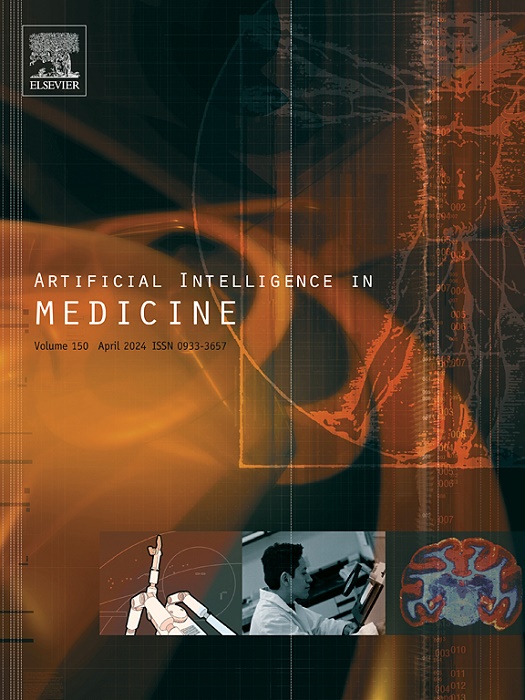BPINet: Synchronous blood pressure estimation and user authentication based on ECG and PPG signal with multi-task learning
IF 6.2
2区 医学
Q1 COMPUTER SCIENCE, ARTIFICIAL INTELLIGENCE
引用次数: 0
Abstract
As a vital indicator of health, blood pressure is particularly important for elderly individuals with chronic illnesses who live alone. Daily monitoring is essential to prevent hypertension and related complications. Nevertheless, most current home blood pressure monitors depend on cuff-based techniques, which can produce inaccurate results through improper use or cuff placement. Moreover, these devices generally cannot identify the specific user being measured, which hinders the development of personalized long-term health monitoring reports. In this paper, we propose BPINet, a multi-task model based on the Multi-gate Mixture-of-Experts (MMoE) framework that utilizes CNN-BiLSTM to extract features from ECG/PPG signals for simultaneous blood pressure estimation and user authentication (identity recognition). We also compile a dataset of ECG/PPG signals from multiple families, along with their blood pressure measurements, and incorporate it with the University of Queensland Vital Signs Dataset (UQVS) to evaluate the performance of BPINet. On the UQVS dataset, BPINet achieves a 97.54% user identity recognition accuracy. For systolic blood pressure (SBP) estimation, BPINet yields an MAE ± STD of 3.317 ± 5.771 mmHg. For diastolic blood pressure (DBP) estimation, the corresponding values are 2.444 ± 4.147 mmHg. On our customized dataset, BPINet achieves a 94.30% user identity recognition accuracy. For SBP estimation, it yields an MAE ± STD of 2.940 ± 4.753 mmHg. These results meet both the British Hypertension Society (BHS) Grade A standard and the Association for the Advancement of Medical Instrumentation (AAMI) standard. BPINet not only performs blood pressure estimation effectively but also enables simultaneous user identity recognition, facilitating the creation of personalized health records. The experimental results demonstrate the clinical feasibility and effectiveness of our proposed scheme.
BPINet:基于ECG和PPG信号的多任务学习同步血压估计和用户认证。
作为一项重要的健康指标,血压对独居的患有慢性疾病的老年人尤为重要。日常监测对于预防高血压及相关并发症至关重要。然而,目前大多数家庭血压计依赖于基于袖带的技术,由于使用不当或袖带放置不当,可能产生不准确的结果。此外,这些设备通常无法识别被测量的特定用户,这阻碍了个性化长期健康监测报告的发展。在本文中,我们提出了一种基于多门混合专家(MMoE)框架的多任务模型BPINet,该模型利用CNN-BiLSTM从ECG/PPG信号中提取特征,用于同时进行血压估计和用户身份认证(身份识别)。我们还编制了来自多个家庭的ECG/PPG信号数据集,以及他们的血压测量数据,并将其与昆士兰大学生命体征数据集(UQVS)合并,以评估BPINet的性能。在UQVS数据集上,BPINet实现了97.54%的用户身份识别准确率。对于收缩压(SBP)估计,BPINet的MAE±STD为3.317±5.771 mmHg。舒张压(DBP)估算值为2.444±4.147 mmHg。在我们定制的数据集上,BPINet实现了94.30%的用户身份识别准确率。对于收缩压估计,MAE±STD为2.940±4.753 mmHg。这些结果既符合英国高血压学会(BHS) A级标准,也符合医疗器械进步协会(AAMI)标准。BPINet不仅可以有效地进行血压估计,还可以同时进行用户身份识别,方便创建个性化的健康记录。实验结果验证了该方案的临床可行性和有效性。
本文章由计算机程序翻译,如有差异,请以英文原文为准。
求助全文
约1分钟内获得全文
求助全文
来源期刊

Artificial Intelligence in Medicine
工程技术-工程:生物医学
CiteScore
15.00
自引率
2.70%
发文量
143
审稿时长
6.3 months
期刊介绍:
Artificial Intelligence in Medicine publishes original articles from a wide variety of interdisciplinary perspectives concerning the theory and practice of artificial intelligence (AI) in medicine, medically-oriented human biology, and health care.
Artificial intelligence in medicine may be characterized as the scientific discipline pertaining to research studies, projects, and applications that aim at supporting decision-based medical tasks through knowledge- and/or data-intensive computer-based solutions that ultimately support and improve the performance of a human care provider.
 求助内容:
求助内容: 应助结果提醒方式:
应助结果提醒方式:


